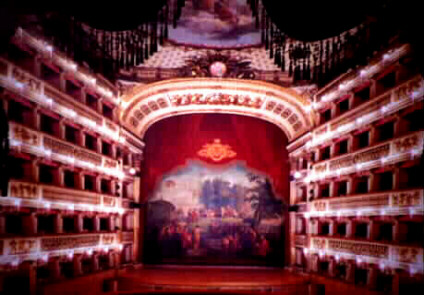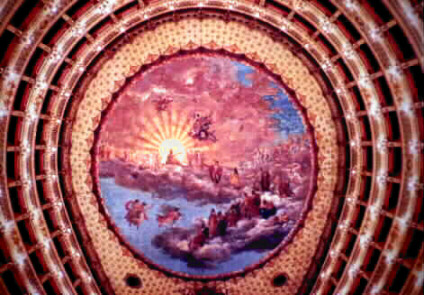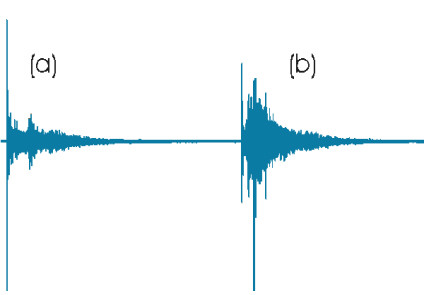Acoustical Society of America
ICA/ASA '98 Lay Language Papers
The Acoustics of the Italian Opera House
"Teatro di San Carlo" in Naples-Italy
"Teatro di San Carlo" in Naples-Italy
Luigi Maffei- maffei@unina.it
Gino Iannace
Carmine Ianniello
Rosario Romano
DETEC - University of Naples Federico II
piazzale Tecchio 80
80125 Naples, Italy
Popular version of paper 2pAAa4
Presented Tuesday afternoon, 23 June, 1998
ICA/ASA '98, Seattle, WA
The Teatro di San Carlo is known to be the oldest working theater in Europe. Since its opening on the 4th November 1737 (41 years before the opening of La Scala in Milan and 51 years before the opening of La Fenice in Venice) a number of famous singers, musicians, conductors, and other artists as well, have brought great prestige to this theater.
It was built by King Charles of Bourbon who wished to provide his capital city with a new theater to substitute the old and crumbling theater of San Bartolomeo to be demolished. On the 4th March 1737 a contract was signed with the architect Giovanni Antonio Medrano and the contractor Angelo Garasale. The completion term was fixed for the end of the same year at a cost of 75,000 ducats. This contract was honored and the San Carlo was opened on the 4th November 1737 - the king's nameday - with Metastasio's opera "Achille in Sciro". The music was by Domenico Sarro who also conducted the orchestra.
After a long period of splendor, during which the outside of the theater was renewed by the architect Antonio Niccolini on the orders of Murat, the Teatro di San Carlo was completely destroyed by a fire on 12th February 1816. Only six days after the fire King Ferdinand of Bourbon entrusted architect Niccolini to rebuild and restore the theater as it had been before the fire.
It's a to-day story. Recently, a historical Italian theater has suffered a severe fire (La Fenice in Venice) and now it must be restored as it was before the destructive event!
By respecting Medrano's plans the auditorium remained horseshoe-shaped, 28.6 m long, 22.5 m wide; the 184 boxes were arranged in six tiers, including the royal one. The stage was enlarged (33.1 m x 34.4 m). The house courtain depicts "Parnassus" by Giuseppe Mancinelli, 1854.

Fig.1 - A view towards the royal box

Fig.2 - A view of the stage from the royal box.
The decorations were renewed and a still existent painting by Giuseppe Cammarano embellished the ceiling. It depicts Apollo introducing the greatest poets in the world to the goddess Minerva .

Fig.3 - Ceiling painting by Giuseppe Cammarano,1816
Apart from the introduction of the orchestra pit, which was suggested by Giuseppe Verdi in 1872, the substitution of the central chandelier for the electrical lighting in 1890, the construction of the new foyer with a new wing given over to the dressing rooms of artists, the theater has undergone no substantial changes.
The auditorium is the same today as when Stendhal saw it the evening of the theater reopening on 12th January 1817. "There is nothing in all Europe, I won't say comparable to this theatre, but which gives the slightest idea of what it is like..., it dazzles the eyes, enraptures the soul...".
Due to safety regulations, the seating capacity of the Teatro di San Carlo is now 1500. The volume of the auditorium is nearly 14,000 m3 without including a 2.3 m deep air space above the canvas by Cammarano. The volume of the stage house is about 27,000 m3. The orchestra pit has an average transverse length of 15.8 m and a width along the centerline, from the stage to the railing, of 7.5 m. The orchestra pit can be given a variable overhung for opera or ballet performance, otherwise it can be closed completely to extend the stage floor.
The San Carlo has never been in short of praise for its acoustics but, surprisingly, no objective study about this subject has ever been published till now. Therefore, acoustic measurements have been carried out by the authors in the aim of describing the acoustics of the San Carlo objectively.
In the past, the ear trained acoustician sensed the acoustic characters of a room by listening to the response of the enclosure to a hand clap. Modern technology allows the capture of a similar "acoustic signature" known as impulse response. It looks like a Christmas tree laying down on a side. This sound pressure signal contains a huge of useful information which, eventually, will tell how the listener will perceive an acoustic event in a room.
The impulse response was recorded at representative locations in the stalls and at the very front of a number of boxes (the sound quality of a TV set is better than that perceived deep in a box.). Tests were carried out in the unoccupied San Carlo when fitted for a symphonic concert. The pit was closed completely and the stage house was decoupled from the main hall, to a certain degree, by a thin wooden curtain covered by a velour glued over its surface. A second set of measurements was carried out when the San Carlo was fitted for an opera performance. In this event the orchestra pit was open almost completely and the stage house was fitted with scenery for the specific performance.
The collected impulse responses allowed the calculation of a number of accepted physical descriptors of the sound quality in a concert hall, that is the Reverberation Time RT, the Early Decay Time EDT, the Clarity C80, the Strength G, in octave bands, and the Lateral Efficiency LE. Strictly, the impulse response depends on both the location of the sound source and the location of the receiver, so do the above-mentioned descriptors. Fig.4 shows an impulse response in the second row in the stalls (a) and in the royal box (b), respectively. Please, see and listen to the difference! mafs.wav

Fig.4.
The consideration of their space averaged values reveals that the Teatro di San Carlo shows objective acoustical characters almost similar to those of other large opera houses of the Italian style, e.g. La Scala in Milan.
In the light of the accepted subjective meaning of the considered physical descriptors, San Carlo appears to be well suited for listening to opera concerts, but it suffers of an excess of clarity and of a weakness of blending and envelopment as far as symphonic music is concerned.
Contact Information Luigi Maffei and Carmine Ianniello can be reached in Seattle during the week of the meeting. They stay at the Westin Hotel (tel.206-728-1000).